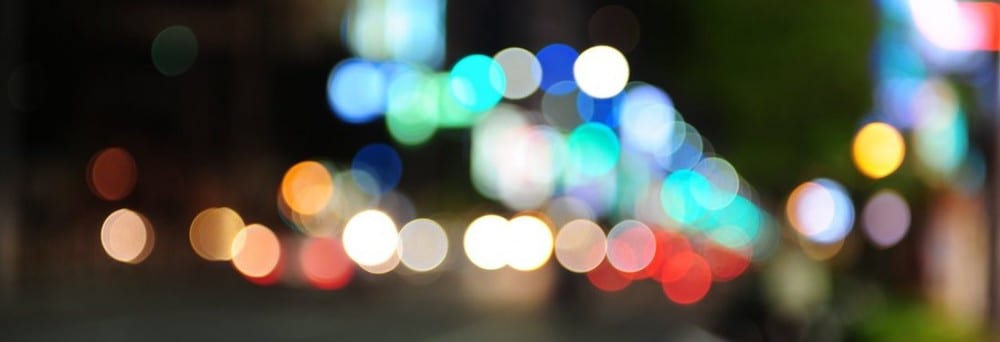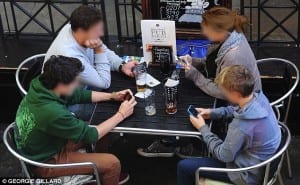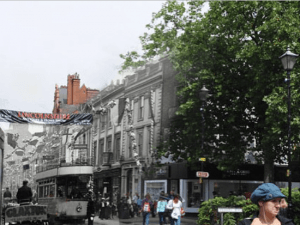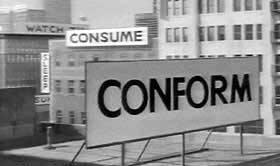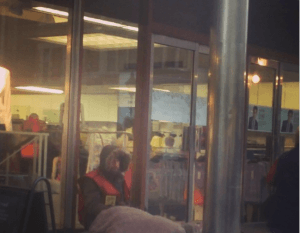Questioning Retail (QR) was a performance conceived from the observation of our dependency on technology, specifically smartphones. The only way an audience member was able to communicate with us, the performers, or understand the content within this performance was through a smartphone. As technology, specifically mobile phones, has become the most successful product of the capitalist culture, Question Retail (QR) quickly developed into a performance that was self-reflective on capitalism and the consumerist culture. Realising that technology, particularly smartphones, have become a basic necessity in our everyday life, it was only fitting that technology be a fundamental component in our performance. Built on the foundations of questioning the system, capitalism, that the retail industry thrives on and the retail environment in relation to humanity, we created a performance that did not intend to criticise consumers in the high street, instead the QR performance intended to enlighten and ignite a conversation between us, the performers, and our audience in order to reflect upon our society. Our collaboration was highly influenced by the expectations of the Frequency Festival which emphasised the theme of liberation. Our performance was structured by the use of QR codes, however although it seems simply this use of technology had not yet been explored in the artistic world until our production. Within this blog I will reflect upon the various concepts and previous site-specific art that inspired and influenced the birth our Question Retail (QR) performance; our process of creating this performance; and finally a reflection on the performance which took place on Lincoln high street on May 7th 2015.
Liberation
Liberation is a state of freedom where the individual ego is eliminated and the true egoless state or the state of self is cognized.’ (Charlie Lutes)
Liberation generally means free or freed from something. After discussing ‘what is liberation’ with the group in our workshop, it became apparent to us that defining this term depends heavily on personal experience. It seems that no two people are able to understand ‘liberation’ in the same way, presumably because we all walk different paths in life that are designed in accordance with our personal goals. Questioning the truth that the word liberation signified, we concluded that liberation means acceptance. Accepting a situation or circumstance in order to understand it and be a part of it or change it. In understanding something, you take away the power of oppression; you remove the unknown that stands as a threat to you. Liberation is a complete shift in a person’s perception and may even penetrate to changing their belief system.
Bases on self-reflectivity, before beginning this Site-specific performance journey I was not aware of the fact that a smartphone made its owner a walking encyclopaedia. With the help of Wi-Fi and data, a smartphone is the key to unlock almost every single piece of information in this world, but not every smart phone owner is aware of their power. The QR performance seeks to liberate its audience from this ignorance; it seeks to demonstrate the greatness that technology has provided humanity with as well as liberate consumers from capitalism for just a moment while they interact with us during our performance.
As liberation was the key ingredient to the piece of site-specific performance that we created, our understanding of the word liberation transformed from meaning freedom and acceptance to simply being aware of the society and time we live in. Our intentions where to liberate our audience from the consumerist culture by stopping them in their tracks to take a minute and observe their surroundings; to bring their awareness to the fact that they are products of a capitalist society; and show them the power they posses as people of this time and their dependency on technology gather than on people.
The consequence of Technology
Albert Einstein said,
“I fear the day technology will surpass our human interaction. The world will have a generation of idiots.” (Mount, 2015)
Sixty years after the death of one of the world greatest minds, it seems Einstein’s prediction has come true. It is certainly acceptable to believe that technology has become a basic necessity to our existence. Thriving on our cravings for instant access to everything with minimal effort, the growth of technology has exceled the expectations of anything humanly imaginable, thus, creating a new breed of people. Einstein presumably was insinuating through the above statement that by being dependent on technology we are further away from humanity than the generation before us. And that perhaps with the growth of technology, humans are evolving into machines that can function entirely solo with absolutely no dependency on anybody else.
Although to many it seems like technology has had a huge negative impact on our basic human skills, it is crucial to acknowledge its benefits. For example long distant communication is faster and far more efficient with the use of Skype, text messaging, directing messaging on social media and email; it has also made knowledge incredibly accessible to anyone, with a communications devise, at any time. However on the other hand, as Einstein feared, technology has had an equally negative effect on people, particular on my generation. From personal experience and from observing the world/ society around me, it has become evident that we live in an era where we would rather text and call then go out and meet. On many occasions you will witness groups of people ‘spending time together/ bonding’ yet everybody within that group is drawn into a technological world through the device that has won over their attention, oblivious to the surrounding that they a physically present in. Physically they are in a place/ location yet mentally they are in a completely different world. With this said, think for a second how many times you may have passed somebody in the street that could have been a major influence in your life, but you missed them because you were looking down at your phone.
Pervasive media and QR Codes
“Pervasive Media is basically any experience that uses sensors and/or mobile/wireless networks to bring you content (film, music, images, a game…) that’s sensitive to your situation – which could be where you are, how you feel, or who you are with.” (Pervasive Media Studios)
Pervasive means to spread throughout. Thus QR codes are the newest form of pervasive media. QR codes are a growing technological means of accessing information. Used by major commercial companies, such as McDonalds, as an easy access portal to their websites. Acknowledging that QR is an abbreviation for quick response, it is evident that technology is simply catering to accommodate our impatiens. QR codes eliminates the effort of having to type in a web address, this form of media owns its rapid growth to the fact that it gives people the option to simply scan a code in order to access the information they seek. First created in 1994 by a company called Denso Wave intended for commercial use. In just twenty-one years, QR code have developed into a portal that allowed scanners to access any sort of information attached to the code, as well as become a quicker way for shoppers to find information on the products they are buying.
For our performance we changed the meaning of QR to stand for Questioning Retail. We also took advantage of the fact that QR code are a digital tool that emphasises how small the internet the world. We consisted many way in which we could use a QR Code to liberate our audience form consumerism. Although we kept our performance simple by wearing a T-shirt and giving out flyers with QR codes printed on them, one of the most thought provoking performance ideas we brain stormed was to temporarily tattoo QR codes to our skin. As QR Codes were originally intended for commercial use, imagine for a moment the affect temporarily tattooing QR Codes to one’s body. Instantly the coded body would be labelled, thus making it a product. For the duration of the tattoo being on the skin, the person does not exists as an individual being, instead they become a product manufactured by society. If QR Codes where tattooed to a person body, as we had intended to do for the performance, Albert Einstein’s fear would be at its peak, because humans would no longer own technology and use it as a tool, instead technology would own the human and use him as a puppet to drive it growth in capitalism. But isn’t this already happening in our society? Although technology has not yet grown to point where it is inbuilt to our bodies, I has already taken over our lives through our dependency on it.
AR Art
Currently QR (quick response) codes are the fastest way to access information. By simply scanning a pixilated code printed on any surface you are taken into a digital world. This advance of technology may be used to introduce an entirely new movement within the artistic culture. In an article entitled, ‘Invisible visualities: Augmented reality art and the contemporary media ecology’, Amada Starling Gould explores AR (Augment reality) artists phenomenal use of technological tools such as QR codes to reveal their work, therefore illuminating a new perceptive on media – media that exists a form of expression.
Inspired by AR artist Tamika Thiel work entitled ‘Transformation’, we devised our entire performance base on the concept of technology being the key to our content. the Only way an audience member could truly partake in our performance was if the they scanned the codes we had on our T-shirts and the codes we handed to them. It is evident through Thiel’s work that the QR codes and the portable devises used to scan these codes are only vehicles that allow a person’s mind to travel to a different space. However, in order for this ‘travel’ to happen, there needs to be a purpose or depth created within a realistic space, as shown in ‘Transformation’. Considering the essence of invisible visualises, this artistic style makes art accessible only through a digital devise, however it does not compromise the essence of traditional art, which is to enlighten and/or express an idea, perspective, emotion etc. Tamika Thiel’s work was particularly influential when we where devising the historical content for our performance.
Capitalism
Capitalism is the social system in which we live. As a system, capitalism thrives on class division and profit motive. It is a system in which the minority rule and everything has a price. Capitalism has become more than just the social system it has become a religion.
In agreement with Russel Brands statement that Capitalism is a religion, Walter Benjamin states in his writing ‘Capitalism as religion’:
“one can behold in capitalism a religion, that is to say, capitalism essentially serves to satisfy the same worries, anguish and disquiet formerly answered by so-called religions.’’ (Walter Benjamin)
In observing the system on which the 21st century western society depends on, it became apparent that money holds a power in capitalism equal to that of God in other religions. If capitalism is a religion and money stood as God within the capitalist religion, the high street would be equivalent to a church. Introducing ‘Retail therapy’, the church of Capitalism claims to help people, consumers, release street and feel better through spending money and gaining material assists.
In regards to our performance, the concept of capitalism being a religion had a significant influence, particularly when exploring social interaction in the high street. Firstly it is important to identify that ‘social interaction’ is a topic that explored people’s relationship with the high street and the characters they portrayed whilst on the high street. The high street is a place where people (consumers) experience the height of capitalism, as it is the church of the capitalist religion. Weather conscious of it or not the people of the high street are followers of capitalism and thus portray certain characteristic similar to that of the capitalist system. For example, whilst overserving the movement of the high street it became apparent to me that many people have a goal they wish to obtain whilst on the high street shopping, this characteristic is also found in the anatomy of the capitalist system. Capitalism is built on obtaining money for growth, thus it is fair to conclude that as consumers we have adapted to the traits of the capitalist system to the point in which we mirror them.
The Situationist movement
Situtaionists’ believed that change began with oneself and that a change in ones perspective of the world would change society. In order to practise their concept, situationists’ seek to disrupt the flow of social norms.
Our performance was on May 7th which was also the day of the general election. In order to subtly reflect this we incorporated Situtaionist art into our performance. Are intentions where to be political without being bias to any party, in order to create this balance we took care to ensure that we did not mention any political parties or discuss our political view points with our audience. As one of the first movements to analyse capitalism it is no surprise that they an Avant-grand artistic approach. With the use of a surreal time portrayed within the images, such as the one below, and the their choice of words and statements, situtaionist artists can be recognised at political critics.
It is evident that situtaionists’ seek to break the norms of society or the habits of the capitalist system by mirroring them in order to illuminate the horrific affects that this system has had on society. Guy Debord’s The Society of the Spectacle is a critique of consumer culture. Debord reflects the control the media and commodities have over consumers.
“As capitalism’s ever-intensifying imposition of alienation at all levels makes it increasingly hard for workers to recognize and name their own impoverishment, putting them in the position of having to reject that impoverishment in its totality or not at all, revolutionary organization has had to learn that it can no longer combat alienation by means of alienated forms of struggle” (libcom.org, 2006)
After researching the situtaionist movement we were inspired to incorporate some its characteristics into our performance. Our aim was to disrupt the flow of the consumers on the high street and having a conversation with them that questioned the capitalism in it current consumerist form.
The Lives of the High street
The lives on the high street where a significant influence in our research for social interaction. By day the high street was home to all consumers and businesses, however by night, the high street turns into a home for the homeless of the city, the people that no body notices whilst shopping or getting to work. The shop doors that to material fulfilment during the day are also a place o sleep for the homeless at night. Whilst observing the movement of the high street it became apparent that unless a homeless man intentionally makes himself noticed nobody sees him; it is as if he just blends in with the concert jungle we call the high street. This observation evidenced a social issue that is hardly spoken about. Below is a picture take of a homeless man on Lincoln high street, I attached the caption ‘Would you help him if you could?’ to this picture as it was used at a source for a QR Code.
I found this image particularly provocative because this man is sitting directly in front of a store, however after observing him and the movement around him I noticed that only a few people stopped and spoke to him or helped him. Personally, I found this incredibly disturbing because capitalism preachers the benefits of retail therapy however as a human being would it not be more fulfilling to help other?
There is no place for art
Initially we intended to past QR Codes on a public wall on the high street, we approached two spaces, the glass shelter and Marks and Spenser’s wall on the high street. However, we were unable to get permission to use either site. Our solution was to criticise capitalism through the use of its main vehicle, marketing. Our performance was simple yet provocative. We gave out QR codes as flyers and portrayed the character of a promoter on the high street. This however meant that our audience struggled to approach us as they thought we were trying to sell them something. What we discovered was that instead of listening to our opening statement where we made clear that we were a performance not a sales pitch many people abruptly stopped us saying ‘I’m not interested’ and hurryingly walked past us. I also observed that because of the character we were portraying many people intentionally avoided us, by moving to the other side of the street; avoiding eye contact and putting their heads down. However, the audience members who did interact with us understood the point of our performance. As a performer I feel that I gained a lot of high concept ideas from interacting with audience that I had not noticed we had explored through our research. For example, I had a conversation with a gentleman who pointed out that our performance highlighted a horrifying social truth. That as a society we worship money because we work for it and most disturbingly is that capitalism has managed to put a price on money and that price is human sacrifice. After this conversation during our performance it came to my attention that every oppression and war that has and the ones that do exist with in our society were driven by money, from slavery to the middle- Eastern wars, the price of money is human sacrifice.
Works Cited
Mount, H. (2015, January 11th). Was Einstein right? Physicist once said he feared that technology would surpass human interaction – and these photos show that time may not be far off . Retrieved from Dailymail online: http://www.dailymail.co.uk/news/article-2929268/Was-Einstein-right-Ph
Thiel, T. (2012, November 22). Tamiko Thiel: Tranformation. Retrieved from Youtube: https://www.youtube.com/watch?v=XdB62q8tZCA
Watershed (2015) Pervasive Media Studio: What is Pervasive Media? [online] Bristol: Watershed. Available from http://www.watershed.co.uk/pmstudio/what-pervasive-media [Accessed on 26/01/2015]
Pearson, M. (2010) Site-Specific Performance. Basingstoke: Palgrave Macmillan.
libcom.org (2006) Situationists – an introduction [online] Available from: https://libcom.org/thought/situationists-an-introduction. [Accessed on 1st May 2015]
Lyotard, J.F. (1984) The Postmodern Condition: A report on knowledge. Translated from French by Geoff Bennington and Brian Massumi. UK: Manchester University Press.
Russel Brand. (2015). Is capitalism a religion. Available: https://www.youtube.com/watch?v=SW2TBJPuoAI. Last accessed 13th May 2015.
